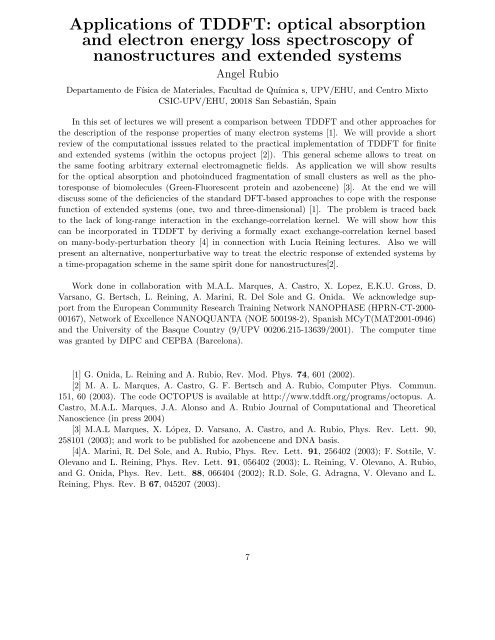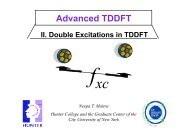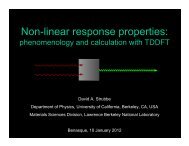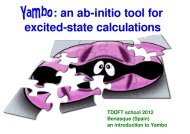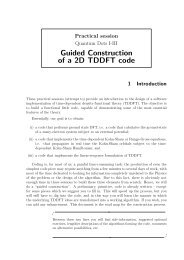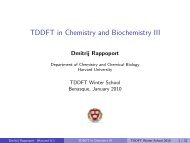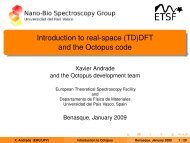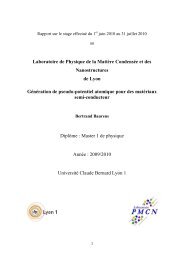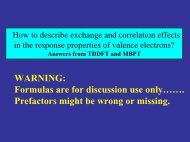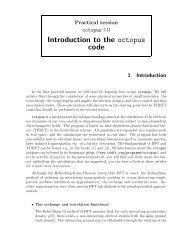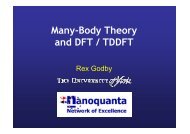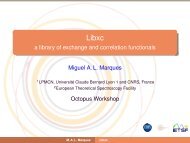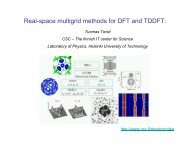TIME DEPENDENT DENSITY FUNCTIONAL THEORY ... - TDDFT.org
TIME DEPENDENT DENSITY FUNCTIONAL THEORY ... - TDDFT.org
TIME DEPENDENT DENSITY FUNCTIONAL THEORY ... - TDDFT.org
- No tags were found...
You also want an ePaper? Increase the reach of your titles
YUMPU automatically turns print PDFs into web optimized ePapers that Google loves.
Applications of <strong>TDDFT</strong>: optical absorption<br />
and electron energy loss spectroscopy of<br />
nanostructures and extended systems<br />
Angel Rubio<br />
Departamento de Física de Materiales, Facultad de Química s, UPV/EHU, and Centro Mixto<br />
CSIC-UPV/EHU, 20018 San Sebastián, Spain<br />
In this set of lectures we will present a comparison between <strong>TDDFT</strong> and other approaches for<br />
the description of the response properties of many electron systems [1]. We will provide a short<br />
review of the computational isssues related to the practical implementation of <strong>TDDFT</strong> for finite<br />
and extended systems (within the octopus project [2]). This general scheme allows to treat on<br />
the same footing arbitrary external electromagnetic fields. As application we will show results<br />
for the optical absorption and photoinduced fragmentation of small clusters as well as the photoresponse<br />
of biomolecules (Green-Fluorescent protein and azobencene) [3]. At the end we will<br />
discuss some of the deficiencies of the standard DFT-based approaches to cope with the response<br />
function of extended systems (one, two and three-dimensional) [1]. The problem is traced back<br />
to the lack of long-range interaction in the exchange-correlation kernel. We will show how this<br />
can be incorporated in <strong>TDDFT</strong> by deriving a formally exact exchange-correlation kernel based<br />
on many-body-perturbation theory [4] in connection with Lucia Reining lectures. Also we will<br />
present an alternative, nonperturbative way to treat the electric response of extended systems by<br />
a time-propagation scheme in the same spirit done for nanostructures[2].<br />
Work done in collaboration with M.A.L. Marques, A. Castro, X. Lopez, E.K.U. Gross, D.<br />
Varsano, G. Bertsch, L. Reining, A. Marini, R. Del Sole and G. Onida. We acknowledge support<br />
from the European Community Research Training Network NANOPHASE (HPRN-CT-2000-<br />
00167), Network of Excellence NANOQUANTA (NOE 500198-2), Spanish MCyT(MAT2001-0946)<br />
and the University of the Basque Country (9/UPV 00206.215-13639/2001). The computer time<br />
was granted by DIPC and CEPBA (Barcelona).<br />
[1] G. Onida, L. Reining and A. Rubio, Rev. Mod. Phys. 74, 601 (2002).<br />
[2] M. A. L. Marques, A. Castro, G. F. Bertsch and A. Rubio, Computer Phys. Commun.<br />
151, 60 (2003). The code OCTOPUS is available at http://www.tddft.<strong>org</strong>/programs/octopus. A.<br />
Castro, M.A.L. Marques, J.A. Alonso and A. Rubio Journal of Computational and Theoretical<br />
Nanoscience (in press 2004)<br />
[3] M.A.L Marques, X. López, D. Varsano, A. Castro, and A. Rubio, Phys. Rev. Lett. 90,<br />
258101 (2003); and work to be published for azobencene and DNA basis.<br />
[4]A. Marini, R. Del Sole, and A. Rubio, Phys. Rev. Lett. 91, 256402 (2003); F. Sottile, V.<br />
Olevano and L. Reining, Phys. Rev. Lett. 91, 056402 (2003); L. Reining, V. Olevano, A. Rubio,<br />
and G. Onida, Phys. Rev. Lett. 88, 066404 (2002); R.D. Sole, G. Adragna, V. Olevano and L.<br />
Reining, Phys. Rev. B 67, 045207 (2003).<br />
7


